







 |
|
 |
 |
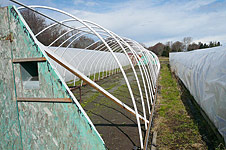 Most of our veggies and fruits are grown outside year-round. However, we do use five green houses for spring and summer seed propagation, and Most of our veggies and fruits are grown outside year-round. However, we do use five green houses for spring and summer seed propagation, and 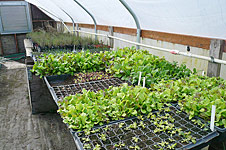 basil production. We also run 2-foot tall drip irrigated plastic tunnels in the Dungeness Field, packed with cucumbers and summer squash. basil production. We also run 2-foot tall drip irrigated plastic tunnels in the Dungeness Field, packed with cucumbers and summer squash.
Greenhouses play an important roll in extending a plant's growing season by a few weeks, or they can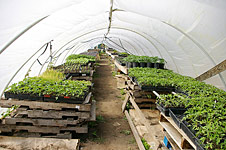 create a complete microclimate that's a successful substitute for the plant's native environment. Nash's uses greenhouses for both purposes, as well as growing seedlings in a protected environment for transplanting once the weather warms up. Most of our early brassicae rotations (cauliflower, broccoli, cabbages) and lettuces start in greenhouses, create a complete microclimate that's a successful substitute for the plant's native environment. Nash's uses greenhouses for both purposes, as well as growing seedlings in a protected environment for transplanting once the weather warms up. Most of our early brassicae rotations (cauliflower, broccoli, cabbages) and lettuces start in greenhouses, 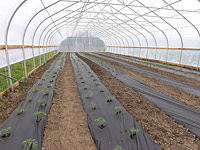 as well as celery, leeks, tomatoes, basil, globe artichokes, summer squash and more. as well as celery, leeks, tomatoes, basil, globe artichokes, summer squash and more.
In 2014, the crew built a new 30’ x 100’ greenhouse specifically for tomato production. The structure will also be used for other vegetables, but most of it will be dedicated to tomatoes. See our Photo Gallery for 2014 for photos of its construction.
|
 |
 |
 |
 When PCC Farmland Trust purchased the Delta Farm in 1999, it was clear to Nash and his team that in order to supply a steady flow of irrigation water to all parts of the farm, they needed a reservoir. The irrigation ditches were not piped in 1999 and the farm’s location near the end of the Dungeness line sometimes made the flow sporadic, depending on that year’s snowfall and how much water the Irrigation District was releasing. When PCC Farmland Trust purchased the Delta Farm in 1999, it was clear to Nash and his team that in order to supply a steady flow of irrigation water to all parts of the farm, they needed a reservoir. The irrigation ditches were not piped in 1999 and the farm’s location near the end of the Dungeness line sometimes made the flow sporadic, depending on that year’s snowfall and how much water the Irrigation District was releasing. 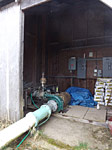 The pond was dug in 2000. It holds about a million gallons, and when the irrigation ditch is flowing, it can fill overnight. Once the ditches close in September, it stays filled with rainfall runoff. During irrigation season, water from the pond is pulled from the pond to the nearby fields by a 40-hp pump at a rate of 300-600 gallons per minute. The pond was dug in 2000. It holds about a million gallons, and when the irrigation ditch is flowing, it can fill overnight. Once the ditches close in September, it stays filled with rainfall runoff. During irrigation season, water from the pond is pulled from the pond to the nearby fields by a 40-hp pump at a rate of 300-600 gallons per minute.
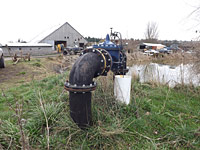 The Clallam Conservation District piped the Dungeness irrigation line in several stages from 2008 to 2011. This improvement is preventing water loss and improving water quality, saving as much as one cubic foot per second. Additionally, a float valve was installed adjacent to the Delta Pond, which allows us to recharge the pond as needed. The Clallam Conservation District piped the Dungeness irrigation line in several stages from 2008 to 2011. This improvement is preventing water loss and improving water quality, saving as much as one cubic foot per second. Additionally, a float valve was installed adjacent to the Delta Pond, which allows us to recharge the pond as needed.
|
 |
 |
The Delta Farm is also home to a three-bin grain dryer. In an effort to keep the grain seed crop viable through the damp winter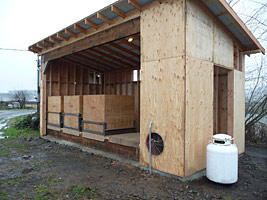 months, Sam McCullough, Dave Roberts and the team at Delta Farm built a grain dryer and a structure to house it. The propane drying unit was previously used by farmers Troy Smith and Gene Adolphsen, who have been raising grain for many years in the Sequim Valley. The 5-hp, triple-phase fan forces warm air into a plenum box, a long, airtight box that supports four bins, whose bases are a series of screens. The air travels through the screens and up into the grain, exiting through the open top. months, Sam McCullough, Dave Roberts and the team at Delta Farm built a grain dryer and a structure to house it. The propane drying unit was previously used by farmers Troy Smith and Gene Adolphsen, who have been raising grain for many years in the Sequim Valley. The 5-hp, triple-phase fan forces warm air into a plenum box, a long, airtight box that supports four bins, whose bases are a series of screens. The air travels through the screens and up into the grain, exiting through the open top.
11-12% moisture is the industry standard for most cereal grains, like wheat or barley, and Sam uses a moisture meter to ensure the grain reaches that percentage. It takes 3-6 hours to dry a ton of grain, but with this new equipment, we are ensured viable seed for the next season.
|
 |
 |
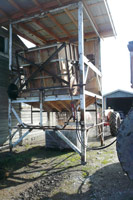 When the grain dryer was put into operation in the winter of 2011, it was discovered that the grain had to be moved to and from specific-sized bins that fit into the dryer’s frame, which took an employee with a bucket a long time to accomplish. So Josh Gloor, Colten Bartlett and Dave Roberts worked together to fabricate a machine that can take a bin loaded by forklift, tilt it, and dump its contents into another bin, enabling one person to reshuffle a ton of grain in a matter of minutes. When the grain dryer was put into operation in the winter of 2011, it was discovered that the grain had to be moved to and from specific-sized bins that fit into the dryer’s frame, which took an employee with a bucket a long time to accomplish. So Josh Gloor, Colten Bartlett and Dave Roberts worked together to fabricate a machine that can take a bin loaded by forklift, tilt it, and dump its contents into another bin, enabling one person to reshuffle a ton of grain in a matter of minutes. |
 |
 |
In the spring of 2011, Nash Huber was visiting the Blue Heron Bakery in Olympia. He struck up a conversation with the owner and discovered that the Bakery had a 70-year-old grain mill that they wanted to get rid of. Nash brought it back to the farm where Dave Roberts went to work rebuilding the housing so that it is an exact replica of the original. It is made of Eastern maple, a hardwood that is extremely dense and able to withstand the vibrations of the milling process. Dave’s finished mill is really a work of art!
The two mill stones are made of Missouri Sandstone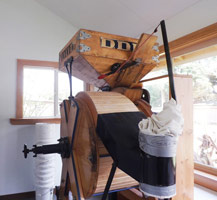 and are about 30 inches in diameter and 6 inches thick. Each weighs about 200 pounds. and are about 30 inches in diameter and 6 inches thick. Each weighs about 200 pounds.
The WSDA-inspected, certified, organic mill room was finished in the spring of 2013. Our customers can purchase red 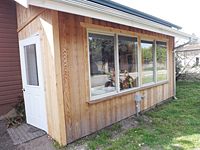 wheat, white wheat, triticale, rye and buckwheat (when available) flours at the Farm Store, Farmers Markets and via the Farm Share Program. wheat, white wheat, triticale, rye and buckwheat (when available) flours at the Farm Store, Farmers Markets and via the Farm Share Program.
The New Grain Mill
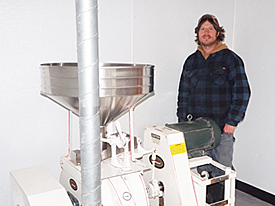 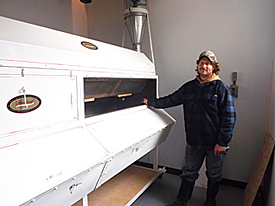
In 2014, Nash’s acquired a new Meadows grain mill (left) and sifter (right, shown with grain supervisor Sam McCullough) from the Bell Street Bakery that closed in Sequim in 2013. A new section of our certified mill room was constructed and the equipment was moved there. The mill is designed to grind grain or corn into flour, meal or grits. This, plus the ability to finely sift the flours, has given the farm a great deal of flexibility in our grain product line. It has also increased the quality, efficiency and speed in our milling process.
All of our organically-grown whole grains and whole grain flours are also available at the above locations for the home miller. Contact the Sales Desk at the Packing Shed for more information about bulk prices on grain and flour pre-orders, 360-681-7458, sales@nashsorganicproduce.com.
|
 |
 |
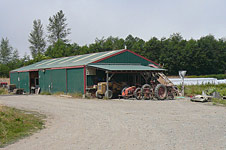 Nash and Patty built the packing shed in 1996. It is a very practical metal structure that measures 50 feet by 30 feet and is home to the packing line, the large cooler (rescued from an old Safeway store in Port Angeles that was being torn down) and the sales office. Nash and Patty built the packing shed in 1996. It is a very practical metal structure that measures 50 feet by 30 feet and is home to the packing line, the large cooler (rescued from an old Safeway store in Port Angeles that was being torn down) and the sales office.
For many years, the sale office was out in the same general area where so much of the work was being done, which was distracting for sales staff, as well as being too dusty for the computers. In 2009, Ernie Kozun, the father of former sales manager Kia Armstrong and a retired shop teacher from Maine, enclosed a corner of the packing shed and created a quiet, more-or-less dust-free area with space for 2 computer stations and storage for the farmers markets—a great improvement for the sales staff.
|
|





